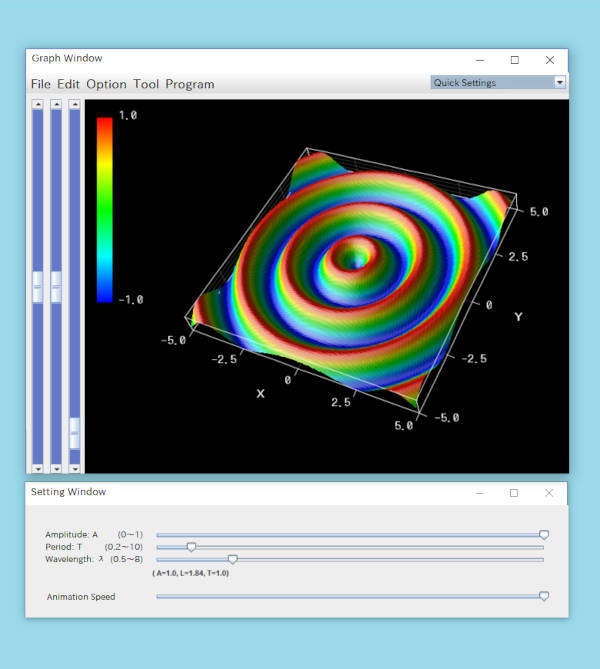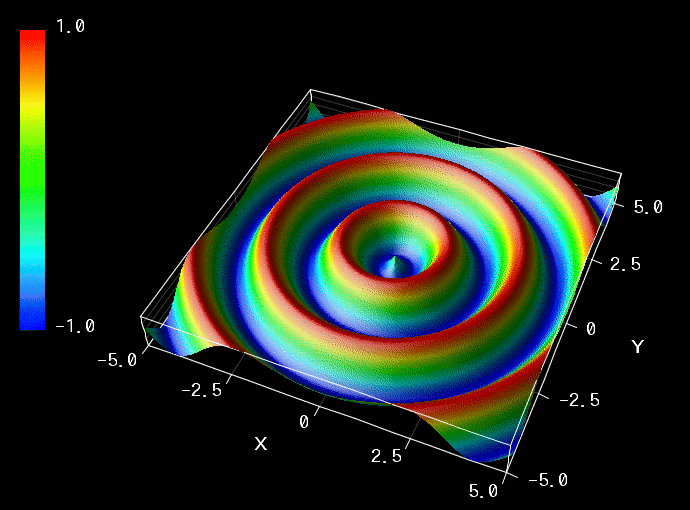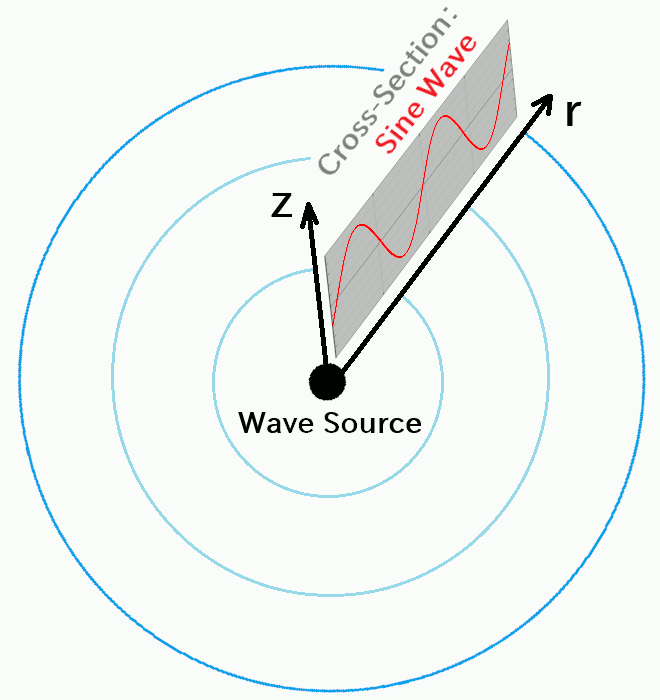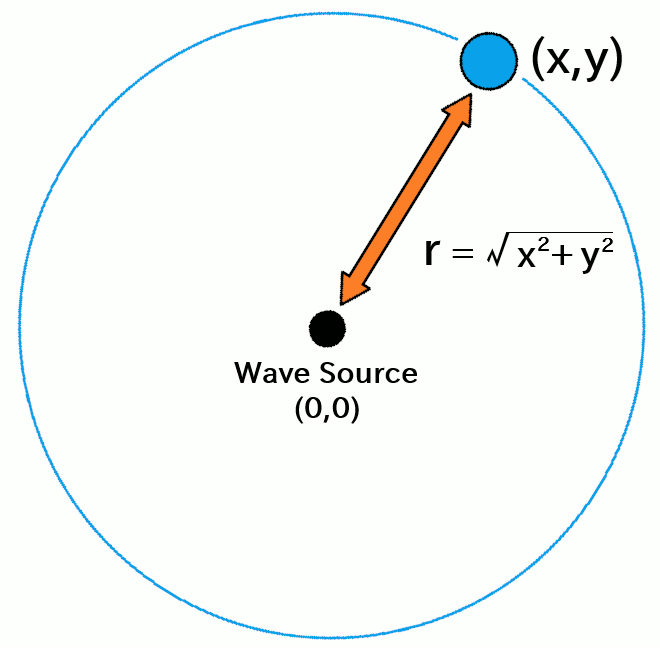For details, see How to Use.
Circular Wave Animation
This is a VCSSL program that animates circular waves propagating across a plane, based on parameters such as amplitude, wavelength, and period.
In the previous article and the one before that, we visualized sine waves propagating along a line -- in other words, on a one-dimensional medium.
This time, we'll extend the idea to two-dimensional media and look at waves that spread out over a surface. Specifically, we'll animate circular waves that radiate outward in concentric circles from a central source.
[ Related Article ]
- Previous: Wave Interference Animation (Two Sine Waves on a Line)
- Two articles back: Sine Wave Animation
How to Use
Download and Extract
At first, click the "Download" button at the above of the title of this page by your PC (not smartphone). A ZIP file will be downloaded.
Then, please extract the ZIP file. On general environment (Windows®, major Linux distributions, etc.), you can extract the ZIP file by selecting "Extract All" and so on from right-clicking menu.
» If the extraction of the downloaded ZIP file is stopped with security warning messages...
Execute this Program
Next, open the extracted folder and execute this VCSSL program.
For Windows
Double-click the following batch file to execute:
For Linux, etc.
Execute "VCSSL.jar" on the command-line terminal as follows:
java -jar VCSSL.jar
» If the error message about non-availability of "java" command is output...
After Launching the Program
When you launch the program, you'll first be asked whether you want to input wave parameters numerically. Unless you have a specific need like "I want this exact wavelength," feel free to skip this step by selecting "No."
After that, two windows will appear: a 3D graph window and a parameter setting window.

In the graph window, you'll see an animated circular wave spreading out. The parameter setting window allows you to control the wave's properties, such as wavelength, amplitude, and period, using sliders.
Closing either window will terminate the program.
Concept Overview
A circular wave occurs when a vibrating source, known as the wave source, transfers its motion outward through the surrounding medium in concentric circles.

If you gently touch the surface of water -- say, in a bathtub -- you'll observe waves radiating outward in a circular shape.
And if you vibrate your finger vertically against the surface, concentric wavefronts will continue to propagate outward. (In that case, your finger acts as the wave source.)
To simplify this motion, let's assume the following:
It's like a stadium wave in sports events -- everyone does the same movement, just shifted in timing based on position.
(Strictly speaking, this assumption isn't perfectly accurate -- for instance, it doesn't preserve energy -- but it greatly simplifies the discussion.)
Now, if the wave source performs a simple harmonic motion, this movement propagates outward with delay proportional to distance.
As a result, if you take a cross-section of the wave in the radial direction, what you'll see is a classic sine wave -- just like the one we examined in the first article of this series.

We define the direction of oscillation -- that is, the direction in which the wave source moves up and down -- as the \(z\)-axis, and the horizontal distance from the wave source as \(r\).
Assuming the wave source is located at the origin of the coordinate system, the distance \(r\) from the wave source to a point \((x,y)\) on the surface is given by:
\[ r = \sqrt{x^2 + y^2} \tag{1}\]Here's how it looks geometrically:

To express the motion mathematically, we can now rewrite the horizontal variable \(x\) in the sine wave equation from the earlier article as \(r\), to obtain a formula for a sine wave that propagates radially from the source:
\[ z = A \sin 2 \pi \bigg( \frac{t}{T} - \frac{r}{\lambda} \bigg) \tag{2} \]This is the mathematical expression for the circular wave shown in the animation. It's a simplified theoretical model that is easy to work with and is often used in introductory explanations of wave interference.
Here, \(A\) is the amplitude, \(\lambda\) the wavelength, and \(T\) the period -- all of which were introduced in this earlier article, so please refer back to that for more detail.
In reality, waves may diminish in amplitude as they spread (i.e., attenuation), and they can reflect off boundaries, producing complex interactions. Equation (2) assumes none of that happens -- it's based on a highly idealized model.
For a more physically realistic simulation of surface wave propagation, take a look at this article:
Even in that simplified simulation, you'll notice that the wave's amplitude quickly drops as soon as it starts, and reflected waves soon interfere, producing a complicated pattern.
In real-world cases, while you can sometimes deal with reflection by adjusting boundary conditions, attenuation is much harder to ignore -- it's inherently tied to the law of conservation of energy. Especially near the source, it's practically impossible to create a situation where attenuation is negligible.
In other words, assuming "no attenuation" when modeling waves spreading over a medium is almost equivalent to assuming that "conservation of energy can be ignored" -- which is a strong and potentially problematic simplification.
That said, using a clean, idealized model like equation (2) has its benefits: It makes it easier to understand the distinctive patterns in circular wave interference, which will be explored in the next article. If you include attenuation from the beginning, things get complex quickly, and explanations tend to become vague or purely descriptive.
So even if it's not physically accurate, there's value in first examining the non-attenuating case. You can understand the core behavior in a simplified setting, and then consider how adding attenuation changes things. Just be sure to keep in mind that this model does not reflect actual physical behavior in its entirety.
Code Overview
This program is written in VCSSL.
Let's go over the contents of the code briefly. VCSSL has a simple C-like syntax, so if you've had any exposure to C or similar languages, you should find it easy to follow.
If you'd like to customize things -- such as the graph's range or other behavior -- just open the program file, CircularWave.vcssl, in a text editor and modify it freely. Since VCSSL is a scripting language, there's no need for a separate compiler or build step -- just save your changes and run.
Full Code
Let's start by looking at the entire code:
coding UTF-8; // Specify character encoding to prevent garbled text
import Math; // Import the library for mathematical functions
import GUI; // Import the library for building GUI windows
import tool.Graph3D; // Import the library for 3D graph plotting
// Variables to store wave parameters
double amplitude = 1.0; // Wave amplitude (A)
double wavelength = 2.0; // Wavelength of the wave (ホサ)
double period = 1.0; // Period of the wave (T)
// Configuration variables for the graph range, number of points, and time increment
const int N = 100; // Number of grid points per axis (higher = smoother mesh)
const double X_MIN = -5.0; // Minimum value on the X-axis
const double X_MAX = 5.0; // Maximum value on the X-axis
const double Y_MIN = -5.0; // Minimum value on the Y-axis
const double Y_MAX = 5.0; // Maximum value on the Y-axis
const double Z_MIN = -1.0; // Minimum value on the Z-axis
const double Z_MAX = 1.0; // Maximum value on the Z-axis
const double DT = 0.1; // Time increment per loop iteration (when speed = 1.0)
const double DX = (X_MAX - X_MIN) / (N-1); // Mesh interval along the X-axis
const double DY = (Y_MAX - Y_MIN) / (N-1); // Mesh interval along the Y-axis
// Coordinate arrays to pass wave data to the graph
double waveX[ N ][ N ]; // X-coordinate array
double waveY[ N ][ N ]; // Y-coordinate array
double waveZ[ N ][ N ]; // Z-coordinate array
// Variables for the GUI (setting window)
int window; // Stores the window ID
int periodSlider; // Stores the ID of the period slider
int wavelengthSlider; // Stores the ID of the wavelength slider
int amplitudeSlider; // Stores the ID of the amplitude slider
int speedSlider; // Stores the ID of the animation speed slider
int infoLabel; // Stores the ID of the label showing current settings
int timeLabel; // Stores the ID of the label showing current time
int resetButton; // Stores the ID of the reset button for time
// Other control variables
float speed = 0.7; // Animation speed
int graph; // Stores the ID of the graph software
bool continuesLoop = true; // Controls whether the animation keeps running
double t; // Time variable
// ======================================================================
// Main procedure - this function runs automatically on startup
// ======================================================================
void main( ){
// Launch the graph window
createGraphWindow();
// Build the GUI (setting window)
createSettingWindow();
t = 0.0; // Initialize time variable
// Animation loop
while( continuesLoop ) {
// Calculate coordinates for the wave and pass them to the graph
for( int yi=0; yi<N; yi++ ) {
for( int xi=0; xi<N; xi++ ) {
double x = X_MIN + xi * DX; // X coordinate at xi-th grid line
double y = Y_MIN + yi * DY; // Y coordinate at yi-th grid line
double r = sqrt(x*x + y*y); // Distance from the origin
waveX[yi][xi] = x;
waveY[yi][xi] = y;
waveZ[yi][xi] = amplitude * sin( 2.0 * PI * ( t/period - r/wavelength ) );
}
}
// Send the wave data to the 3D graph
setGraph3DData( graph, waveX, waveY, waveZ );
// Advance time (scaled by animation speed)
t += DT * speed;
// Wait for 30 milliseconds to control animation speed
sleep( 30 );
}
exit(); // Exit the program when animation loop ends
}
// ======================================================================
// 繧ーFunction to launch and configure the 3D graph window
// ======================================================================
void createGraphWindow() {
// Launch the 3D graphing software
graph = newGraph3D( 0, 0, 800, 600, "Graph Window" );
// Load fine-tuned settings (e.g., aspect ratio, scale, view angle) from a config file
setGraph3DConfigurationFile(graph, "RinearnGraph3DSetting.ini");
// Disable auto range and manually set the graph range
setGraph3DAutoRange( graph, false, false, false );
setGraph3DRange( graph, X_MIN, X_MAX, Y_MIN, Y_MAX, Z_MIN, Z_MAX );
// Plot settings: disable point markers, enable surface plot
setGraph3DOption(graph, "WITH_POINTS", false);
setGraph3DOption(graph, "WITH_MEMBRANES", true);
}
// ======================================================================
// Function to build the setting window
// ======================================================================
void createSettingWindow() {
// Create the window
window = newWindow( 0, 610, 800, 230, "Setting Window" );
// Create and place the time display label
timeLabel = newTextLabel( 10, 10, 200, 20, "" );
mountComponent( timeLabel, window );
// Create and place the labels to the left of sliders
int amplitudeLabel = newTextLabel( 10, 40, 135, 15, "A: Amplitude (0-1)" );
mountComponent( amplitudeLabel, window );
int omegaLabel = newTextLabel( 10, 60, 135, 15, "T: Period (0.2-10)" );
mountComponent( omegaLabel, window );
int lambdaLabel = newTextLabel( 10, 80, 135, 15, "ホサ: Wavelength (1-8)" );
mountComponent( lambdaLabel, window );
// Create and place the amplitude slider (range 0.0-1.0)
amplitudeSlider = newHorizontalSlider( 150, 40, 600, 20, amplitude, 0.0, 1.0 );
mountComponent( amplitudeSlider, window );
// Create and place the period slider (range 0.2-10.0)
periodSlider = newHorizontalSlider( 150, 60, 600, 20, period, 0.2, 10.0 );
mountComponent( periodSlider, window );
// Create and place the wavelength slider (range 1.0-8.0)
wavelengthSlider = newHorizontalSlider( 150, 80, 600, 20, wavelength, 1.0, 8.0 );
mountComponent( wavelengthSlider, window );
// Create and place the label to show current slider values
infoLabel = newTextLabel( 150, 100, 400, 20, "" );
mountComponent( infoLabel, window );
updateInfoLabel();
// Create and place the label and slider for animation speed
int speedLabel = newTextLabel( 10, 140, 140, 15, "Animation Speed" );
mountComponent( speedLabel, window );
speedSlider = newHorizontalSlider( 150, 140, 400, 20, speed, 0.0, 1.0 );
mountComponent( speedSlider, window );
// Create and place the reset button for time
resetButton = newButton(600, 125, 150, 40, "Reset Time");
mountComponent( resetButton, window );
// Refresh the window after placing components
paintComponent( window );
}
// ======================================================================
// Function to update the label that shows current slider values
// ======================================================================
void updateInfoLabel() {
string infoText
= "( A="
+ round(amplitude, 2, HALF_UP) // Round amplitude to 2 decimal place
+ ", ホサ="
+ round(wavelength, 2, HALF_UP) // Round wavelength to 2 decimal places
+ ", T="
+ round(period, 2, HALF_UP) // Round period to 2 decimal places
+ ")";
setComponentString(infoLabel, infoText);
paintComponent(infoLabel);
paintComponent(window);
}
// ======================================================================
// Event handler: called when a slider is moved
// ======================================================================
void onSliderMove(int id, float value) {
// Set the value to the corresponding global variable
if(id == amplitudeSlider) {
amplitude = value;
}
if(id == periodSlider) {
period = value;
}
if(id == wavelengthSlider) {
wavelength = value;
}
if (id == speedSlider) {
speed = value;
}
updateInfoLabel();
}
// ======================================================================
// Event handler: called when a button is clicked
// ======================================================================
void onButtonClick(int id) {
// If the reset button is clicked, reset time variable t
if (id == resetButton) {
t = 0.0;
}
}
// ======================================================================
// Event handler: called when the window is closed
// ======================================================================
void onWindowClose(int id) {
// Exit the animation loop and terminate the program
continuesLoop = false;
}
// ======================================================================
// Event handler: called when the 3D graph window is closed
// ======================================================================
void onGraph3DClose(int id) {
// Exit the animation loop and terminate the program
continuesLoop = false;
}
That's it! The program is just under 250 lines long.
Each section is explained in the comments within the code itself, but let's go over a few key parts in more detail, especially those that differ from the sine wave animation program two articles ago.
The overall structure is nearly identical to the previous version -- the only major changes are that:
- The wave data is now two-dimensional instead of one-dimensional.
- A 3D graph is used instead of a 2D graph.
If you haven't already, reviewing the previous sine wave animation article is highly recommended to understand the basics.
In this article, we'll focus on the differences from that version.
Variable Declarations
The variable declarations at the top of the code are mostly the same as before, but we've added new variables to handle the Z-direction, which wasn't needed for 1D waves.
// Variables to store wave parameters
double amplitude = 1.0; // Wave amplitude (A)
double wavelength = 2.0; // Wavelength of the wave (ホサ)
double period = 1.0; // Period of the wave (T)
// Configuration variables for the graph range, number of points, and time increment
const int N = 100; // Number of grid points per axis (higher = smoother mesh)
const double X_MIN = -5.0; // Minimum value on the X-axis
const double X_MAX = 5.0; // Maximum value on the X-axis
const double Y_MIN = -5.0; // Minimum value on the Y-axis
const double Y_MAX = 5.0; // Maximum value on the Y-axis
const double Z_MIN = -1.0; // Minimum value on the Z-axis
const double Z_MAX = 1.0; // Maximum value on the Z-axis
const double DT = 0.1; // Time increment per loop iteration (when speed = 1.0)
const double DX = (X_MAX - X_MIN) / (N-1); // Mesh interval along the X-axis
const double DY = (Y_MAX - Y_MIN) / (N-1); // Mesh interval along the Y-axis
// Coordinate arrays to pass wave data to the graph
double waveX[ N ][ N ]; // X-coordinate array
double waveY[ N ][ N ]; // Y-coordinate array
double waveZ[ N ][ N ]; // Z-coordinate array
The arrays "waveX", "waveY", and "waveZ" store the coordinates of each point on the mesh grid where the wave is defined.
In the earlier sine wave version, the wave was confined to a one-dimensional line along the X-axis, so a 1D array was sufficient.
Here, the wave exists on a 2D surface (the X-Y plane), so we use **2D arrays** to define a mesh grid of points.
The mesh consists of N grid points along both X and Y, meaning there are (N-1) intervals along each axis. The spacing of those intervals is given by "DX" and "DY", respectively.
main Function
Now let's take a look at the main() function:
// ======================================================================
// Main procedure - this function runs automatically on startup
// ======================================================================
void main( ){
// Launch the graph window
createGraphWindow();
// Build the GUI (setting window)
createSettingWindow();
t = 0.0; // Initialize time variable
// Animation loop
while( continuesLoop ) {
// Calculate coordinates for the wave and pass them to the graph
for( int yi=0; yi<N; yi++ ) {
for( int xi=0; xi<N; xi++ ) {
double x = X_MIN + xi * DX; // X coordinate at xi-th grid line
double y = Y_MIN + yi * DY; // Y coordinate at yi-th grid line
double r = sqrt(x*x + y*y); // Distance from the origin
waveX[yi][xi] = x;
waveY[yi][xi] = y;
waveZ[yi][xi] = amplitude * sin( 2.0 * PI * ( t/period - r/wavelength ) );
}
}
// Send the wave data to the 3D graph
setGraph3DData( graph, waveX, waveY, waveZ );
// Advance time (scaled by animation speed)
t += DT * speed;
// Wait for 30 milliseconds to control animation speed
sleep( 30 );
}
exit(); // Exit the program when animation loop ends
}
This structure is also nearly identical to the earlier sine wave version.
Inside the animation loop ( "while (continuesLoop)" ), the program advances time step-by-step, calculates the wave height for each point on the 2D surface, stores it in an array, and passes the result to the 3D graph renderer.
The key part is where the wave values are calculated and stored in the arrays:
double x = X_MIN + xi * DX; // X coordinate at xi-th grid line
double y = Y_MIN + yi * DY; // Y coordinate at yi-th grid line
double r = sqrt(x*x + y*y); // Distance from the origin
waveX[yi][xi] = x;
waveY[yi][xi] = y;
waveZ[yi][xi] = amplitude * sin( 2.0 * PI * ( t/period - r/wavelength ) );
Here, the 3rd and 7th lines directly correspond to the equations (1) and (2) shown earlier in this article:
\[ r = \sqrt{x^2 + y^2} \tag{1} \] \[ z = A \sin 2 \pi \bigg( \frac{t}{T} - \frac{r}{\lambda} \bigg) \tag{2} \]That's the equation of a circular sine wave expressed in code form.
The program works like a flipbook: it repeatedly computes equation (2) for increasing values of \(t\), sending the result to the 3D graph for animation.
This part forms the core logic of the simulation. The rest of the code is mostly concerned with building the GUI, managing the graph display, and general setup.
As for graph-related parts: VCSSL makes it easy to switch between 2D and 3D graphs using a nearly identical interface. Most of the changes are just replacing "2D" with "3D" in the function names. GUI setup and event handling also follow the same pattern as before.
License
This VCSSL/Vnano code (files with the ".vcssl" or ".vnano" extensions) is released under the CC0 license, effectively placing it in the public domain. If any sample code in C, C++, or Java is included in this article, it is also released under the same terms. You are free to use, modify, or repurpose it as you wish.
* The distribution folder also includes the VCSSL runtime environment, so you can run the program immediately after downloading.
The license for the runtime is included in the “License” folder.
(In short, it can be used freely for both commercial and non-commercial purposes, but the developers take no responsibility for any consequences arising from its use.)
For details on the files and licenses included in the distribution folder, please refer to "ReadMe.txt".
* The Vnano runtime environment is also available as open-source, so you can embed it in other software if needed. For more information, see here.
|
Wave Interference Animation (Two Circular Waves on a Plane) |
|
|
|
Interactive simulator for visualizing wave interference between two circular waves on a plane. |
|
Circular Wave Animation |
|
|
|
Interactive simulator for animating circular waves on a plane with adjustable parameters. |
|
Wave Interference Animation (Two Sine Waves on a Line) |
|
|
|
Interactive simulation of wave interference between two 1D sine waves. |
|
Sine Wave Animation |
|
|
|
Interactive simulator for animating sine waves with adjustable parameters. |
|
Vnano | Solve The Lorenz Equations Numerically |
|
|
|
Solve the Lorenz equations, and output data to plot the solution curve (well-known as the "Lorenz Attractor") on a 3D graph. |










